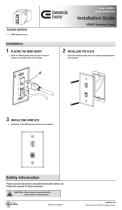
ENGLISH - 11
Contents
Contents
Read this first! ............................................2
Chapter 1 Preparation
Precautions for use ................................................. 14
Cautions when transporting .................................. 14
Cautions when installing ....................................... 14
Security ................................................................ 15
Cautions on use ................................................... 15
Notes on Using Wireless Connection ................... 16
Disposal ................................................................ 17
Accessories .......................................................... 18
Contents of the supplied CD-ROM ....................... 19
Optional accessories ............................................ 19
About your projector ............................................... 20
Remote control ..................................................... 20
Projector body ...................................................... 21
Preparing the remote control ................................. 24
Inserting and Removing batteries ......................... 24
When using the multiple projectors ...................... 24
Chapter 2 Getting Started
Setting up ................................................................. 26
Installation mode .................................................. 26
Parts for ceiling mount (Optional) ......................... 26
Screen size and throw distance ........................... 27
Adjusting adjustable foot ...................................... 30
Connecting ............................................................... 31
Before connecting ................................................ 31
Connecting example : AV equipment ................... 32
Connecting example : Computers ........................ 33
Chapter 3 Basic Operations
Powering on/off ....................................................... 35
Connecting the power cord .................................. 35
Power indicator ..................................................... 35
Powering On the Projector ................................... 36
A PIN code input screen appears ........................ 36
Making adjustments and selections ..................... 37
Powering Off the Projector ................................... 37
Projecting ................................................................. 38
Selecting the input signal ..................................... 38
How to adjust the state of the image .................... 38
Basic operations by using the remote control ..... 39
Using the automatic setup function ...................... 39
Switching the input signal ..................................... 39
Switching the aspect ratio of the image ................ 40
Using the keystone distortion and curved
correction functions ........................................... 40
Using the information function .............................. 40
Using the freeze function ...................................... 41
Using the AV mute function .................................. 41
Using the presentation timer function ................... 41
Switching the lamp power .................................... 41
Using the digital zoom function ............................ 41
Controlling the volume of the speaker .................. 42
Switching the image mode ................................... 42
Using the mute function ........................................ 42
Using the Daylight View Lite function ................... 43
Setting the remote control ID numbers ................. 43
Chapter 4 Settings
Menu Navigation ...................................................... 45
Navigating through the menu ............................... 45
Main menu ............................................................ 46
Sub-menu ............................................................. 47
Input menu ............................................................... 49
Switching the input source ................................... 49
[Display] menu ......................................................... 50
[Auto PC adj.] ....................................................... 50
[Fine sync] ............................................................ 50
[H Position] ........................................................... 50
[V Position] ........................................................... 51
[H.Size] ................................................................. 51
[Aspect] ................................................................ 51
[Project way] ......................................................... 52
[Menu position] ..................................................... 52
[Background display] ............................................ 52
[System] ............................................................... 52
[Color adjust] menu ................................................. 53
[Image mode] ....................................................... 53
[Contrast] .............................................................. 53
[Brightness] .......................................................... 53
[Color] ................................................................... 54
[Tint] ...................................................................... 54
[Color temp.] ......................................................... 54
[Red] / [Green] / [Blue] .......................................... 54
[Sharpness] .......................................................... 55
[Daylight View] ...................................................... 55
[Setting] menu ......................................................... 56
[On start] ............................................................... 56
[Standby mode] .................................................... 56
[High land] ............................................................ 56
[Lamp control] ....................................................... 57
[Cooling fast] ........................................................ 57
[Closed caption] .................................................... 57
[Key lock] .............................................................. 58
[Iris] ....................................................................... 58
[Sound] ................................................................. 58
[HDMI Setup] ........................................................ 59
[Expand] menu ......................................................... 60
[Language] ........................................................... 60
[Auto setup] .......................................................... 60
Contents
Be sure to read “Read this rst!” from
page 2.




















